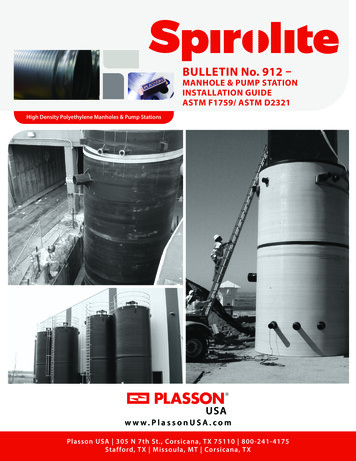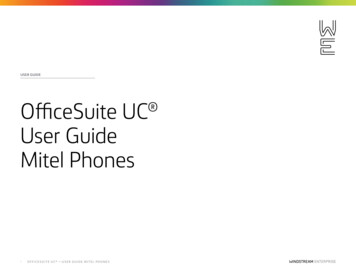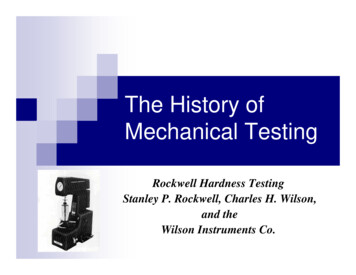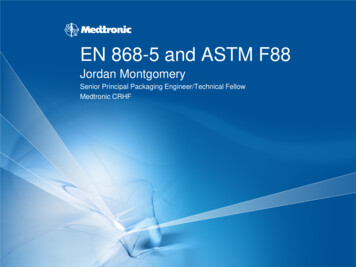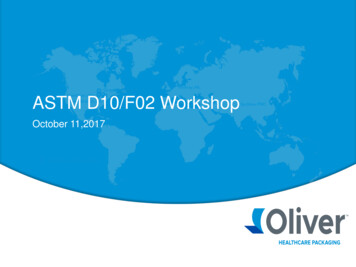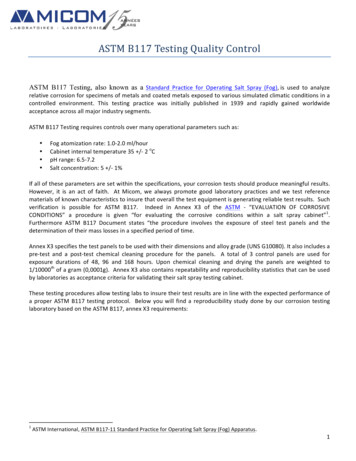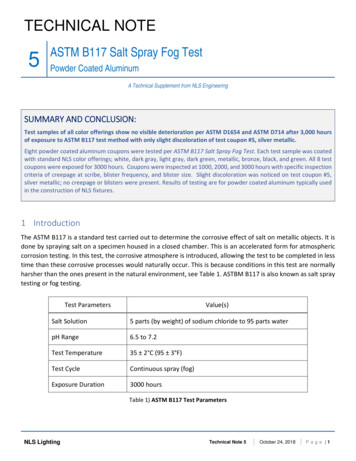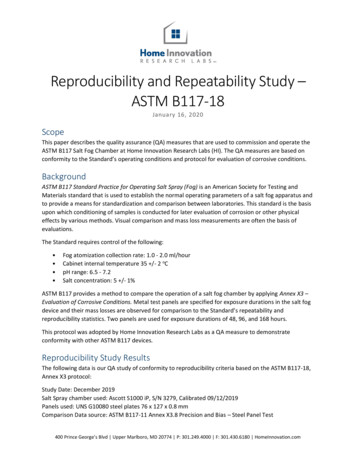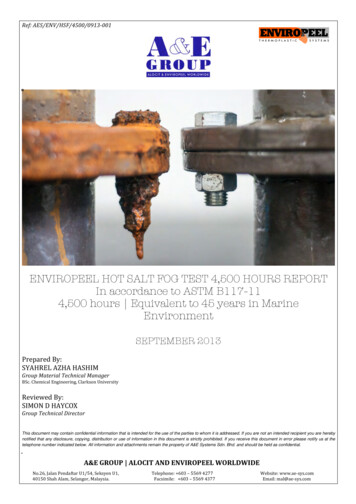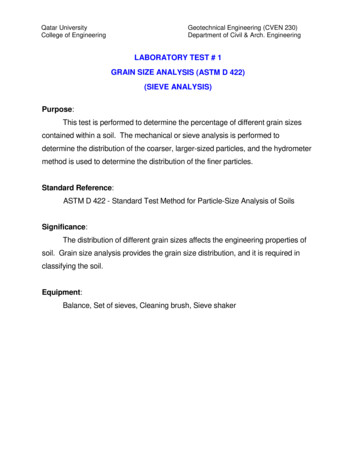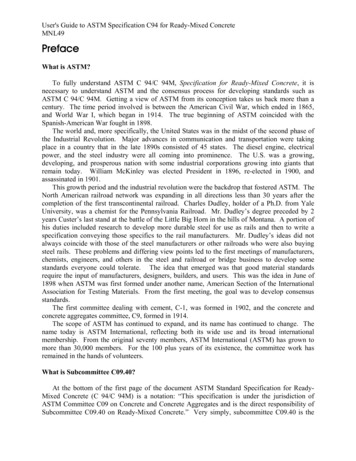
Transcription
User's Guide to ASTM Specification C94 for Ready-Mixed ConcreteMNL49PrefaceWhat is ASTM?To fully understand ASTM C 94/C 94M, Specification for Ready-Mixed Concrete, it isnecessary to understand ASTM and the consensus process for developing standards such asASTM C 94/C 94M. Getting a view of ASTM from its conception takes us back more than acentury. The time period involved is between the American Civil War, which ended in 1865,and World War I, which began in 1914. The true beginning of ASTM coincided with theSpanish-American War fought in 1898.The world and, more specifically, the United States was in the midst of the second phase ofthe Industrial Revolution. Major advances in communication and transportation were takingplace in a country that in the late 1890s consisted of 45 states. The diesel engine, electricalpower, and the steel industry were all coming into prominence. The U.S. was a growing,developing, and prosperous nation with some industrial corporations growing into giants thatremain today. William McKinley was elected President in 1896, re-elected in 1900, andassassinated in 1901.This growth period and the industrial revolution were the backdrop that fostered ASTM. TheNorth American railroad network was expanding in all directions less than 30 years after thecompletion of the first transcontinental railroad. Charles Dudley, holder of a Ph.D. from YaleUniversity, was a chemist for the Pennsylvania Railroad. Mr. Dudley’s degree preceded by 2years Custer’s last stand at the battle of the Little Big Horn in the hills of Montana. A portion ofhis duties included research to develop more durable steel for use as rails and then to write aspecification conveying those specifics to the rail manufacturers. Mr. Dudley’s ideas did notalways coincide with those of the steel manufacturers or other railroads who were also buyingsteel rails. These problems and differing view points led to the first meetings of manufacturers,chemists, engineers, and others in the steel and railroad or bridge business to develop somestandards everyone could tolerate. The idea that emerged was that good material standardsrequire the input of manufacturers, designers, builders, and users. This was the idea in June of1898 when ASTM was first formed under another name, American Section of the InternationalAssociation for Testing Materials. From the first meeting, the goal was to develop consensusstandards.The first committee dealing with cement, C-1, was formed in 1902, and the concrete andconcrete aggregates committee, C9, formed in 1914.The scope of ASTM has continued to expand, and its name has continued to change. Thename today is ASTM International, reflecting both its wide use and its broad internationalmembership. From the original seventy members, ASTM International (ASTM) has grown tomore than 30,000 members. For the 100 plus years of its existence, the committee work hasremained in the hands of volunteers.What is Subcommittee C09.40?At the bottom of the first page of the document ASTM Standard Specification for ReadyMixed Concrete (C 94/C 94M) is a notation: “This specification is under the jurisdiction ofASTM Committee C09 on Concrete and Concrete Aggregates and is the direct responsibility ofSubcommittee C09.40 on Ready-Mixed Concrete.” Very simply, subcommittee C09.40 is the
User's Guide to ASTM Specification C94 for Ready-Mixed ConcreteMNL49group of people who do the actual writing of ASTM C 94/C 94M. This subcommittee istypically composed of approximately 50 people with a wide variety of interests related to theproduction, delivery, and use of ready-mixed concrete. Some of the groups represented on thesubcommittee include producers of ready-mixed concrete; private engineers from both designfirms and material testing firms; state highway department engineers; representatives of federalagencies; representatives of trade organizations; professors from universities, both foreign anddomestic; contractors; representatives from concrete material producers, such as cement andchemical admixtures; as well as others who have a relationship to the industry. Most of thesepeople are engineers or scientists whose daily activities involve them with the concrete industry.Most, but not all, live in the United States.Members of subcommittee C09.40 currently meet twice a year to propose and draft potentialupdates or changes and to commence the balloting process needed to alter the ASTM C 94/C94M standard. The C09.40 subcommittee is responsible for only two ASTM documents. Themost widely used is ASTM C 94/C 94M, and the other is ASTM Specification for ConcreteMade by Volumetric Batching and Continuous Mixing (C 685/C 685M). The latter is thespecification for concrete made from materials continuously batched by volume, mixed in acontinuous mixer, and delivered in a freshly mixed condition. Historically, the method ofbatching and mixing takes place in a truck-mounted unit specifically designed for this purpose.The C09.40 subcommittee is only one of many subcommittees which function as a part of theCommittee C09 on Concrete and Concrete Aggregates. The main C09 committee divides intoapproximately 25 to 30 subcommittees to develop consensus standards for the concrete andconcrete aggregates industry.ASTM Standards Development ProcessThe development of standards using a consensus process can be a painstaking adventure.The rewards are meaningful standards that benefit users with due consideration of the concernsof all involved parties.New standards or alterations to existing standards often begin their formation at the taskgroup level of a subcommittee. The task group prepares a letter ballot for the subcommitteemembership to review for up to 30 days prior to voting. For a subcommittee letter ballot toproceed to the next level, several things must occur. At least 60 % of the subcommittee mustreturn a ballot, and of those voting affirmative and negative, at least 2/3 must be affirmative.Negative voters must provide a reason for their negative vote. Each negative will be consideredat the next biannual subcommittee meeting. The negative vote will be discussed, and thenegative voter is provided the opportunity to speak in defense of the negative and to expound onthe reason for it. During this discussion, the Committee may accept the negative voter’s point ofview and consider it for a revised ballot. If a resolution cannot be reached, a vote is then taken ofmembers present, with affirmative votes required from at least 2/3 of those voting affirmativeand negative to find the negative voter not persuasive and allow the item to advance to acommittee letter ballot.If the subcommittee had a majority of manufacturers (producers), it would be possible thatthe proposed changes or new standards would favor the producers. Control by any single groupis prevented by limiting votes to one per company or organization and by balance. Eachsubcommittee and each committee must have a balance between producers and non-producers.A balanced committee or subcommittee must meet the criterion that voting producer members
User's Guide to ASTM Specification C94 for Ready-Mixed ConcreteMNL49cannot outnumber the combined votes of the other voting membership groups (users, consumers,and general interest). This is a strictly enforced requirement by ASTM.Items passing successfully through the subcommittee process are placed on a committeeletter ballot and again go through the same process, where a larger group of peers has theopportunity to evaluate the proposal. Committee C09 consists of many subcommittees, witheach of these members now eligible to vote. The primary difference in the committee procedurefrom the subcommittee procedure is that a 90 % affirmative vote of those voting affirmative andnegative is now required for passage, rather than 2/3. If a negative vote is found persuasive, theitem fails and is sent back to the subcommittee and task group for a decision on whether tosimply drop the proposed change or make alterations in line with the thoughts of the negativevoter, thereby beginning the process again.Simultaneously with the committee level vote, the proposed change is also subject to a voteby the entire ASTM Society, which includes all the ASTM members in various committees. Novoting percentages are required at this level, but negative votes must again be considered.The consensus system also provides for appeals by a negative voter. The appeals systemvaries depending upon the grounds stated for the appeal.The primary point in the entire process is that each negative voter’s voice and arguments areheard, and the subcommittee or committee is then afforded the opportunity to vote on an issuebased on the thoughts and reasoning of one member of the group. A single objection ofteninfluences others and alters the content of a proposal or kills the proposal completely. ASTMfirmly believes in the old adage that two heads are better than one and has set up a system toensure that each member’s voice is heard.Original ASTM Specification for Ready-Mixed ConcreteThe original C – 9 (now C09) committee required 6 years (1914–1920) to issue its firststandard. The report consisted of the proper means of molding and storing concrete cylinders inthe field, describing methods still in use today. The report also included tentative test methodsfor the unit weight of concrete aggregates and a method for determining voids in concrete fineaggregate. Some additional test methods were also included in the C – 9 report, but nothing onready-mixed concrete was included at that time.The first such specification was issued in 1933 as a tentative specification for ready-mixedconcrete. A copy of the original document that was approved in 1935 is included in theAppendix. The identification number, or designation, was C 94 – 35. The topics covered did notvary much from today’s standard, over 70 years later. One example is that central mixing,partial mixing (shrink mixing), and truck mixing are each included within the specification. Thetime of hauling was limited to 1 ½ hours, as it is today. Testing was specified but did not includeany mention of air content tests, because the advantages of entrained air did not become knownuntil later in the same decade.The specification has been revised many times since 1935 and continues to undergo revisionsto remain in step with technological advances, such as load-cell weighing, and environmentalissues, such as limiting plant runoff water by the use of non-potable water in the batchingprocess.The roots of a successful specification go back to the abilities of the committee prior to 1933that published a very comprehensive document for the materials, proportioning, mixing,delivery, quality, inspection, testing, and acceptance of ready-mixed concrete delivered to the job
User's Guide to ASTM Specification C94 for Ready-Mixed ConcreteMNL49site ready for use.End Result SpecificationSpecifications are basically one of three types: Proprietary, Prescriptive, or Performance(End Result). Concrete specifications are definitely not Proprietary, because brand names areseldom mentioned, and even when they are, it is usually in the context of Brand Z or approvedequal.Prescriptive specifications provide detailed descriptions of required materials and theirproperties but do not provide brand names. This type of specification also provides details ofhow to perform specific parts of the process. The “how to” segment is what ASTM C 94/C 94Mdoes not do. Within the materials segment, ASTM C 94/C 94M does specify specific materialrequirements such as Specification C 150, Type I portland cement and Specification C 33aggregates meeting a specific coarse aggregate grading. Minimum cement quantities andmaximum water quantities may be specified (prescriptive). Ordering Option B provides thepurchaser the opportunity to specify the exact quantities for specific materials and by doing soforfeits any restrictions for final consistency of the delivered product or strength of the hardenedproduct.The bulk of the ASTM C 94/C 94M standard is a performance or end-result specification.The end result is actually divided into two phases. The first phase is the fresh concrete asdelivered in terms of uniformity for placeability and finishability and features such as slump, aircontent, and temperature. ASTM C 94/C 94M does provide a slump range (prescriptive) withinwhich the concrete must be, as a consistency requirement, but ASTM C 94/C 94M makes noattempt to describe how to achieve the slump, the air content, or the temperature. The control ofplaceability and finishability is assisted by the batching accuracy requirements, but there is nohint of describing a method to fulfill these requirements. Thus, phase one of meeting specifiednumerical requirements is primarily an end-result specification.Phase two is the hardened concrete requirement for strength. ASTM C 94/C 94M does notprescribe a method of achieving these minimum strengths, thus it is an end-result specificationwhen hardened concrete is considered.As a whole, ASTM C 94/C 94M is a combined specification with a heavy emphasis onperformance (end result) as compared to the prescriptive segments.Documents Similar to ASTM C 94/C 94MThere are numerous specifications available that address the manufacturing and delivery ofready-mixed concrete. Most of these have been developed by governmental agencies that aretypically Federal or State. The general purpose of these specifications is the same as that ofASTM C 94/C 94M with the difference that they are tailored to the specific purpose of thesponsoring agency. This is the reason that such specifications should be viewed with caution byother potential users.The Forest Service under the umbrella of the U.S. Department of Agriculture has a minispecification within its document, “Specifications for Construction of Roads & Minor DrainageStructures.” The title gives a clue regarding the concrete specification when it says
ASTM Committee C09 on Concrete and Concrete Aggregates and is the direct responsibility of Subcommittee C09.40 on Ready-Mixed Concrete.” Very simply, subcommittee C09.40 is the . User's Guide to ASTM Specification C94 for Ready-Mixed Concrete MNL49 group of people who do the actual writing of ASTM C 94/C 94M. This subcommittee is typically composed of approximately 50 people
